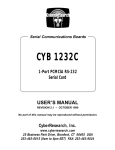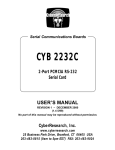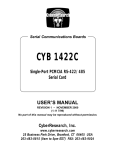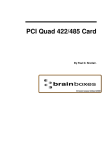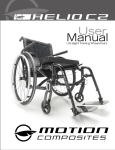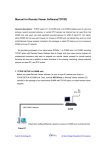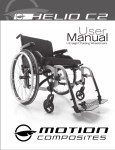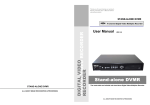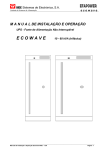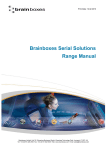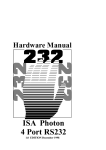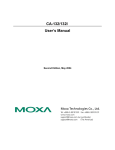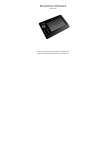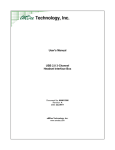Download PCMCIA 1 Port RS232
Transcript
232 232 232 PCMCIA 1 Port RS232 2.1 EDITION OCTOBER 1999 Guarantee. FULL 36 MONTHS GUARANTEE. We guarantee your interface card for a full 36 months from purchase, parts and labour, provided it has been used in the specified manner. In the unlikely event of failure return your interface to your Dealer, with proof of purchase, who will determine whether to repair or replace this product with an equivalent unit. COPYRIGHT. COPYRIGHT © 1985-1999. All rights reserved. No part of this hardware, circuitry or manual may be duplicated, copied, transmitted or reproduced in any way without the prior written consent of the Manufacturer. Due to the Manufacturers commitment to quality, software is subject to continuous improvements: information regarding upgrades can be obtained from your supplier. supplied to you by: ACKNOWLEDGEMENTS. IBM, COMPAQ, Hewlett Packard, H.P. and EPSON are trademarks of the relevant companies. Windows is a trademark of Microsoft. PCMCIA 1 Port RS232 Introduction The Layout Of This Manual THE LAYOUT OF THIS MANUAL Chapter 1 - Hardware Configuration, Summarises the features of the PCMCIA 1 Port RS232 Card. Chapter 2 – Installing the card into the PC, Explains how to insert a new PCMCIA card Chapter 3 –Software Installation This chapter details how to install and configure the PCMCIA 1 Port RS232 Card in Windows 95, Windows 98, Windows Millenium and Windows 2000. Chapter 4 – RS232 Port Cabling Intro 2 PCMCIA 1 Port RS232 Introduction Table Of Contents. CHAPTER 1 HARDWARE GUIDE ...............................................4 Introduction...............................................................................4 PCMCIA 1 Port RS232 Card Features. ...................................4 Configuring PCMCIA Cards. ...................................................4 CHAPTER 2 INSTALLING IN YOUR COMPUTER..................5 CHAPTER 3 SOFTWARE INSTALLATION .............................6 Introduction...............................................................................6 Windows 95 Installation ...........................................................6 Windows 95 CD ROM Installation Procedure .........................7 Windows 95 Floppy Disk Installation Procedure .....................9 Windows 98/Millenium Installation .......................................10 Windows 98/Millenium CD Installation Procedure ...............11 Windows 98/Millenium Floppy Installation Procedure..........13 PCMCIA Card Setup in Windows 95/ 98/Millennium...........15 PCMCIA Port Setup in Windows 95/98/Millennium.............16 Windows 2000 Installation .....................................................19 Windows 2000 CD ROM Installation Procedure ...................20 Windows 2000 Floppy Installation Procedure........................23 PCMCIA Port Setup in Windows 2000..................................25 Windows NT4 Installation......................................................27 Windows CE Installation ........................................................30 CHAPTER 4 RS232 PINOUTS AND PORT CABLING. ..........33 Introduction.............................................................................33 The RS232 Standard. ..............................................................33 Serial Port Pin Outs.................................................................34 9 Pin D Serial Port RS232 Cables...........................................34 9 Pin D Serial Port Connection To Another PC. ....................35 9 Pin D Serial Port To A Modem............................................37 9 Pin D Serial Port Loop Back Connector. .............................37 INDEX .............................................................................................40 Intro 3 PCI PCMCIA RS232 Installing the Card 1 Po rt CHAPTER 1 HARDWARE GUIDE Introduction. This chapter details the specifications of the PCMCIA 1 Port RS232 Serial card. PCMCIA 1 Port RS232 Card Features. * One RS232 Serial port. * Reliable communications up to 50 feet, 15m, and beyond! * 100% 16C550 PC Compatible serial port, up to 115200 Baud. 16950 Compatible FIFO provides 16-byte input and 16-byte output buffer on each port. * Full modem control TXD, RXD, DSR, DCD, DTR, RTS, CTS and RI signals. * Fully double buffered for reliable asynchronous operation. High speed integrated circuitry ensures operation with fast PC’s e.g. 600 MHz Pentium III. * Fully Plug and Play. * Hot Pluggable Dimensions: I/O Connection: Serial Port: Weight: 2 x 3.3 in, 85x55 mm 9 pin Male D type. 16g Configuring PCMCIA Cards. PCMCIA cards, by definition, require no hardware configuration and can be installed "directly from the box". Chapter 2 Page 4 PCMCIA 1 Port RS232 Installing the Card CHAPTER 2 INSTALLING IN YOUR COMPUTER This card is ‘hot plug’ compatible it may be inserted into your pcmcia type 2 slot when the machine is either off or powered on. Please refer to your machine user guide for detailed instructions on inserting a PC card. Chapter 2 Page 5 PCMCIA 1 Port RS422/485 Software Installation CHAPTER 3 SOFTWARE INSTALLATION Introduction. This section describes the software installation procedure allowing the PCMCIA 1 port RS232 to be configured within the Windows 95, Windows 98, Windows Millenium and Windows 2000 operating systems. Windows 95 Installation • Insert the card into an available type2 socket. This can be done even if the machine is powered ON. • If installing from a "power off" condition Windows 95 should then load normally. During the booting process, Windows 95 will detect the card and briefly display a message box indicating the detection process. • Windows will then display the "Update Device Driver Wizard", requesting “insert any disk which came with the card”. Insert the Serial Solutions CDROM installation disk or the Serial Solutions floppy disk into an appropriate drive and click 'Next' . Chapter 3 Page 6 PCMCIA 1 Port RS422/485 Software Installation Windows 95 CD ROM Installation Procedure Click Other Locations Type <drive>:\diskimg\sswin9x substituting the letter of your CD ROM drive for <drive> Click OK Chapter 3 Page 7 PCMCIA 1 Port RS422/485 Software Installation Click Finish Click OK *Type<drive>:\diskimg\sswin9x substituting the letter of your CD ROM drive for <drive> Click OK Chapter 3 Page 8 PCMCIA 1 Port RS422/485 Software Installation Windows 95 Floppy Disk Installation Procedure Click Finish Click OK Type a:\ Click OK Chapter 3 Page 9 PCMCIA 1 Port RS422/485 Software Installation Windows 98/Millenium Installation • The installation for Windows 98 and Windows Millenium are the same. • Insert the card into an available type2 socket. This can be done even if the machine is powered ON. • If installing from a "power off" condition Windows 98 should then load normally. During the booting process, Windows 98 will detect the card and briefly display a message box indicating the detection process. • Windows will then display the "Update Device Driver Wizard", requesting “insert any disk which came with the card”. Insert the Serial Solutions CDROM installation disk or the Serial Solutions floppy disk into an appropriate drive and click 'Next' . Chapter 3 Page 10 PCMCIA 1 Port RS422/485 Software Installation Windows 98/Millenium CD Installation Procedure Choose the “Search for the best driver for your device” Click Next Select Specify a location Type <Drive>:\diskimg\sswin9x\ Where <Drive> is the letter of your CDROM Drive Click Next Chapter 3 Page 11 PCMCIA 1 Port RS422/485 Software Installation Click Next Click Finish Chapter 3 Page 12 PCMCIA 1 Port RS422/485 Software Installation Windows 98/Millenium Floppy Installation Procedure Choose the “Search for the best driver for your device” Click Next Select Floppy disk drives Click next Chapter 3 Page 13 PCMCIA 1 Port RS422/485 Software Installation Click next Click Finish Chapter 3 Page 14 PCMCIA 1 Port RS422/485 Software Installation PCMCIA Card Setup in Windows 95/ 98/Millennium Right Click My Computer -> Properties on the desktop Click on the Device Manager tab Under Multi-function adapters double-click on PCMCIA 1 Port 422 Card Chapter 3 Page 15 PCMCIA 1 Port RS422/485 Software Installation Click on the Serial Solutions tab The Serial Solutions tab allows modification of any user controlled features for the card PCMCIA Port Setup in Windows 95/98/Millennium Right Click My Computer -> Properties on the desktop Chapter 3 Page 16 PCMCIA 1 Port RS422/485 Software Installation Under Ports (COM &LPT) double-click on PCMCIA RS422 PORT (COM*) *is the number allocated to the port. Click on the Port Settings tab Chapter 3 Page 17 PCMCIA 1 Port RS422/485 Software Installation Settings available in this window are: Baud Rate. Data Bits. Parity. Stop Bits. Flow Control. Change to suit remote device. Restore Defaults - When clicked, this will reset the selected port to the default values of: Baud Rate: 9600 Data Bits: 8 Parity: None Stop Bits: 1 Flow Control: Xon / Xoff Maximum Baud Rate Setting These settings allow access to the faster data rates available on this card. The faster rates are not enabled by default for compatibility purposes. The faster data rates are only available directly from your application if it uses the standard Windows dialogue for serial port settings. Baud Rate Multiplier This enables applications that do not use the standard Windows serial port configuration dialogue to access the faster data rates. e.g. with this option enabled, an application which selects 115,200 baud will actually set the hardware to the fastest possible rate of 921,600 baud. In other words the baud rate is multiplied by a factor of 8. Chapter 3 Page 18 PCMCIA 1 Port RS422/485 Software Installation Windows 2000 Installation • Insert the card into an available type2 socket. This can be done even if the machine is powered ON. • If installing from a "power off" condition Windows 2000 should then load normally. During the booting process, Windows 2000 will detect the card and briefly display a message box indicating the detection process. • Windows will then display the "Found New Hardware Wizard", requesting “insert any disk which came with the card”. Insert the Serial Solutions CDROM installation disk or the Serial Solutions floppy disk into an appropriate drive and click 'Next' . Chapter 3 Page 19 PCMCIA 1 Port RS422/485 Software Installation Select "Search for a suitable driver for my device" Click Next Windows 2000 CD ROM Installation Procedure Select Specify a location Click Next Chapter 3 Page 20 PCMCIA 1 Port RS422/485 Software Installation Type <Drive>:\diskimg\sswin2k\ Where <Drive> is the letter of your CDROM Drive Click OK Click Next Chapter 3 Page 21 PCMCIA 1 Port RS422/485 Software Installation Please note, at the time of creation of this document, Windows2000 is still in BETA, and it is not possible to get drivers signed by Microsoft. Brain Boxes fully intend to have obtained a driver signature for this product shortly after the operating system is available on general release. Click Yes Click Finish Chapter 3 Page 22 PCMCIA 1 Port RS422/485 Software Installation Windows 2000 Floppy Installation Procedure Select Floppy disk drives Click next Click Next Chapter 3 Page 23 PCMCIA 1 Port RS422/485 Software Installation Please note, at the time of creation of this document, Windows2000 is still in BETA, and it is not possible to get drivers signed by Microsoft. Brain Boxes fully intend to have obtained a driver signature for this product shortly after the operating system is available on general release. Click Yes Click Finish Chapter 3 Page 24 PCMCIA 1 Port RS422/485 Software Installation PCMCIA Port Setup in Windows 2000 Right Click My Computer -> Properties on the desktop Select the Hardware Tab Click Device Manager Chapter 3 Page 25 PCMCIA 1 Port RS422/485 Software Installation Click on Ports (COM & LPT) Double Click on Brain Boxes Serial Port Select the Port Settings Tab Click on Advanced Chapter 3 Page 26 PCMCIA 1 Port RS422/485 Software Installation From this Screen COM port allocations can be changed. Windows NT4 Installation Though the PCMCIA 1 Port RS232 card can be used in Windows NT4 it is not yet available as a hot-pluggable card . Before inserting the card Click on Start => Settings => Control Panel Chapter 3 Page 27 PCMCIA 1 Port RS422/485 Software Installation Double Click on the Ports Icon. Note the COM Ports Listed Click Cancel. Power down your computer Insert the PCMCIA Card. Power up your computer. Chapter 3 Page 28 PCMCIA 1 Port RS422/485 Software Installation Click on Start => Settings => Control Panel Double Click on the Ports Icon. The New port listed (in this case COM2 will be the PCMCIA card port. Chapter 3 Page 29 PCMCIA 1 Port RS232 RS232 Pinouts & Port Cabling Windows CE Installation Place card in socket Select Start Programs Communications Remote Networking Select: " Make New Connection ", with your pen Chapter 4 Page 30 PCMCIA 1 Port RS232 RS232 Pinouts & Port Cabling Type a name for the connection in the field under "Type a name for the connection" Select "Dial up Connection" Radio button Select Next>" The Dialog shows a modem Icon previous screen with the name from the There is a drop down dialog underneath "Select a Modem" Select Brain_Boxes-1port_RS232 Card Chapter 4 Page 31 PCMCIA 1 Port RS232 Select configure Button Device propreties set the following Baud Rate Data Bits Parity Stop Bits Flow Control RS232 Pinouts & Port Cabling 9600 8 None 1 None Chapter 4 Page 32 PCMCIA 1 Port RS232 RS232 Pinouts & Port Cabling CHAPTER 4 RS232 PINOUTS AND PORT CABLING. Introduction. This chapter gives details of the 9 and 25 pin RS232 pin outs, cabling and connections, with information on how to connect the serial ports of two PCs and how to make a selftest loop back connector. The RS232 Standard. The RS232 standard is ancient in computer industry terms. Introduced in 1962, it is now widely established. RS232 is a slow, short distance, single ended transmission system (i.e. only one wire per signal). Typical RS232 maximum cable length is 50 feet with a maximum data rate of 20K bits per second. Figure 4-1. RS232 Point To Point Connection. TTL D Ground R TTL Ground RS232C Standard 1 Driver 1 Receiver Line Length Max Data Rate 50 Feet = 15m 20 Kbits/sec Chapter 4 Page 33 PCMCIA 1 Port RS232 RS232 Pinouts & Port Cabling Serial Port Pin Outs. The pinouts of the 9 and 25 pin Male D connectors are given below. Figure 4-2. Serial Port RS232 Pin Outs. PIN 6 - DATA SET READY (DSR) PIN 7 - REQUEST TO SEND (RTS) PIN 8 - CLEAR TO SEND (CTS) PIN 9 - RING INDICATOR (RI) PIN 1 - DATA CARRIER DETECT (DCD) PIN 2 - RECEIVED DATA (RXD) PIN 3 - TRANSMITTED DATA (TXD) PIN 4 - DATA TERMINAL READY (DTR) PIN 5 - GROUND (GND) 9 Pin connector: 25 Pin connector: P IN 20 - R IN G IN D IC AT O R (R I) P IN P IN P IN P IN P IN P IN P IN 2 3 4 5 6 7 8 - T R A N S M IT TED DATA (T XD ) R E C E IV E D D ATA (R X D ) R E Q U E ST TO SE N D (RT S) C L E A R T O S EN D (C T S ) D ATA S ET R EA DY (D SR ) G RO U N D (G N D) D ATA C AR R IE R D ETE C T (D C D ) PIN 22 - D ATA T ER M IN A L R E A DY (D T R ) 9 Pin D Serial Port RS232 Cables. To connect to the AT style RS232 Serial Port like those found on the PCMCIA 1 Port card you will need a cable terminating in a 9 way female D connector. It is sound practice to use cables with screws fitted that will allow you to fasten the cable securely to the PC card. In general, you will need to make up a "cross over" cable to correctly interface the PC to the RS232 port of another computer or device. Traditionally, making up the cross over cable has been Chapter 4 Page 34 PCMCIA 1 Port RS232 RS232 Pinouts & Port Cabling considered a black art. However, provided you have the pin outs and handshake requirements of both sides of your RS232 connection, the cross over cable becomes a matter of common sense. The cross over cable is simply to ensure that the right signals going out of one RS232 port go into the appropriate lines of the other RS232 port. 9 Pin D Serial Port Connection To Another PC. Suppose we want to connect the AT style 9 pin D Serial Port to the serial port of another IBM PC. See Figure 4-3. 1) Connect the earth lines. Line 5 of Serial Port 2 to lines 1 & 7 of the other PC. This gives the two devices a common earth level. 2) Connect the Transmit and Receive lines together. Line 3, TXD, Port 2 goes to line 3, RXD, of the other PC. Line 2, RXD, Port 2 goes to line 2, TXD, of the other PC. This allows each to receive data transmitted by the other. 3) Connect the Port 2 DTR line, pin 4 to the other PC DCD, pin 8 and CTS, pin 5, lines. Also, connect up the other PC DTR line, pin 20 to the Port 2 DCD, pin 1 and CTS, pin 8, lines. This allows the receiving device to signal when it can no longer accept data. The receiving device sets DTR false when it is unable to receive any more data. The sending device reads DTR on its CTS and DCD pins. It should stop sending when CTS goes false. 4) Connect the Port 2 RTS line, pin 7, to the other PC DSR line, pin 6. Also, connect the other PC RTS line, pin 4, to the Port 2 DSR line, pin 6. This RTS line is used to let the other device know that it is ready for data exchange. Figure 4-3. 9 Pin D Serial Port To Other PC Cable. Chapter 4 Page 35 PCMCIA 1 Port RS232 AT SERIAL PORT Side 9 PIN D CONNECTOR RS232 Pinouts & Port Cabling Other PC SERIAL PORT Side. 9 PIN D CONNECTOR S C H E M AT IC R E P R E S E N TAT IO N : 5 3 2 7 6 4 8 1 5 2 3 6 7 1 8 4 A C T U A L R E P R E S E N TAT IO N : 1 5 6 9 2 4 7 8 3 3 8 7 4 2 9 6 1 9 PIN D CONNECTOR 5 25 PIN D CONNECTOR S C H E M AT IC R E P R E S E N TAT IO N 5 3 2 7 6 4 8 1 A C T U A L R E P R E S E N TAT IO N Chapter 4 Page 36 PCMCIA 1 Port RS232 RS232 Pinouts & Port Cabling 9 Pin D Serial Port To A Modem. If you are connecting a MODEM to a 9 pin D Serial Port then you will NOT need a cross over cable and a straight through cable connected as the 9 to 25 pin adapter given in Figure 4-5. 9 Pin D Serial Port Loop Back Connector. A loop back connector can be used to echo RS232 data transmitted by a serial port back into its own RS232 receiver. In this way, the function of the serial port can be tested. For an AT style Serial Port use the a female 9 way connector wired as in Figure 4-4. Figure 4-4. 9 Pin D Serial Loop Back Connector. 9 PIN D CONNECTOR 25 PIN D CONNECTOR S C H E M AT IC R E P R E S E N TAT IO N : 2 3 3 2 7 8 6 1 4 4 5 6 8 20 A C T U A L R E P R E S E N TAT IO N : Figure 4-5. 9 To 25 Way Adapter. Chapter 4 Page 37 PCMCIA 1 Port RS232 RS232 Pinouts & Port Cabling This adapter cable makes the AT style 9-pin serial port, look like the standard PC 25 pin serial port. It is NOT a cross over cable! 9 Pin AT SERIAL PORT 9 Pin Female D Connector 25 Pin PC SERIAL PORT 25 Pin Male D Connector S C H E M AT IC R E P R E S E N TAT IO N : 5 1 2 3 4 6 7 8 9 A C T U A L R E P R E S E N TAT IO N : Chapter 4 Page 38 Index INDEX 16450 / 16550 ................................................................................. 4 adapter .................................................................................... 37, 38 asynchronous .................................................................................. 4 baud / baud rate............................................................................... 4 bits ................................................................................................ 33 buffer .............................................................................................. 4 buffered........................................................................................... 4 cable............................................................................ 33, 34, 37, 38 connectors ..................................................................................... 34 cross over .......................................................................... 34, 37, 38 CTS........................................................................................... 4, 35 DCD.......................................................................................... 4, 35 DSR .......................................................................................... 4, 35 DTR .......................................................................................... 4, 35 FIFO................................................................................................ 4 handshake ..................................................................................... 35 loop back................................................................................. 33, 37 modem ............................................................................................ 4 pin outs ................................................................................... 33, 35 port / ports......................................................... 4, 33, 34, 35, 37, 38 receive........................................................................................... 35 RI .................................................................................................... 4 RS232 ....................................................................... 4, 6, 33, 34, 37 RTS........................................................................................... 4, 35 RXD.......................................................................................... 4, 35 serial port ................................................................ 4, 33, 35, 37, 38 speed ............................................................................................... 4 TXD .......................................................................................... 4, 35 Windows......................................................................................... 2









































